HI5004 Marketing Management Report: Coles Private Label Strategy
VerifiedAdded on 2022/12/12
|10
|2195
|267
Report
AI Summary
This report provides a comprehensive marketing analysis of Coles, a major Australian retailer. It begins with an introduction to the importance of marketing management and its role in understanding market trends and customer needs. The report then delves into market positioning analysis, evaluating Coles' current strategy and offering recommendations for improvement, particularly in relation to its private label brands. A detailed market analysis follows, examining Coles' competitive landscape and market share, with a focus on the challenges posed by competitors like Woolworths. The report identifies niche features of Coles, such as its private label brands and product assortment, and evaluates the customer adoption process for Coles' offerings. Furthermore, the report analyzes product pricing and distribution strategies, providing recommendations for optimizing these aspects to enhance market share and customer reach. The conclusion summarizes the key findings and emphasizes the importance of adapting marketing strategies to achieve long-term business viability. The report is based on the provided assignment instructions to analyze the context and environments in which Coles operates, developing marketing strategies based on the learning from lectures.
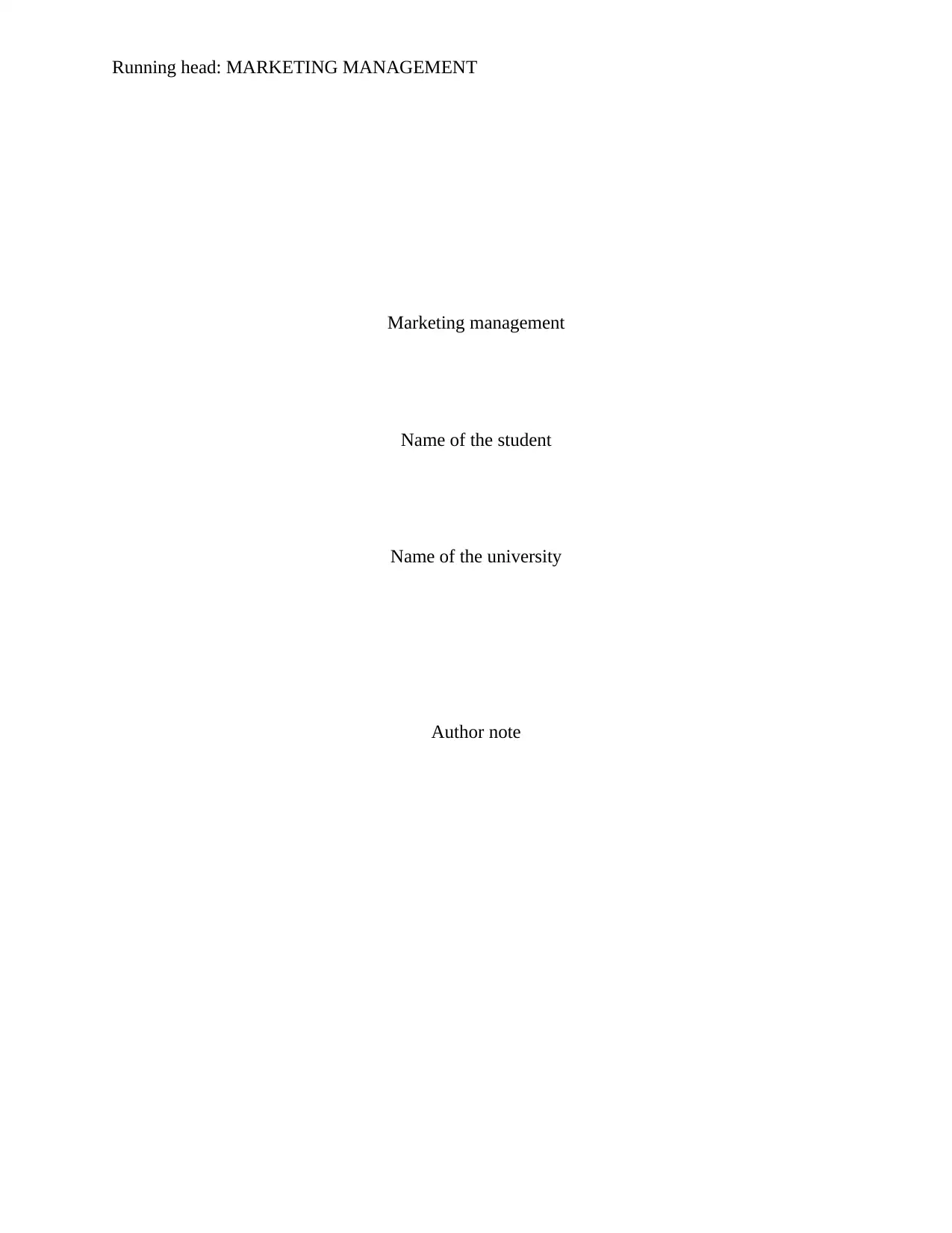
Running head: MARKETING MANAGEMENT
Marketing management
Name of the student
Name of the university
Author note
Marketing management
Name of the student
Name of the university
Author note
Paraphrase This Document
Need a fresh take? Get an instant paraphrase of this document with our AI Paraphraser

1MARKETING MANAGEMENT
Table of Contents
Introduction......................................................................................................................................2
Market positioning analysis.............................................................................................................2
Market analysis................................................................................................................................4
Identification of the niche features..................................................................................................4
Evaluation of the customer adoption process..................................................................................5
Product pricing analysis...................................................................................................................6
Product distribution analysis............................................................................................................7
Conclusion.......................................................................................................................................7
Reference.........................................................................................................................................8
Table of Contents
Introduction......................................................................................................................................2
Market positioning analysis.............................................................................................................2
Market analysis................................................................................................................................4
Identification of the niche features..................................................................................................4
Evaluation of the customer adoption process..................................................................................5
Product pricing analysis...................................................................................................................6
Product distribution analysis............................................................................................................7
Conclusion.......................................................................................................................................7
Reference.........................................................................................................................................8
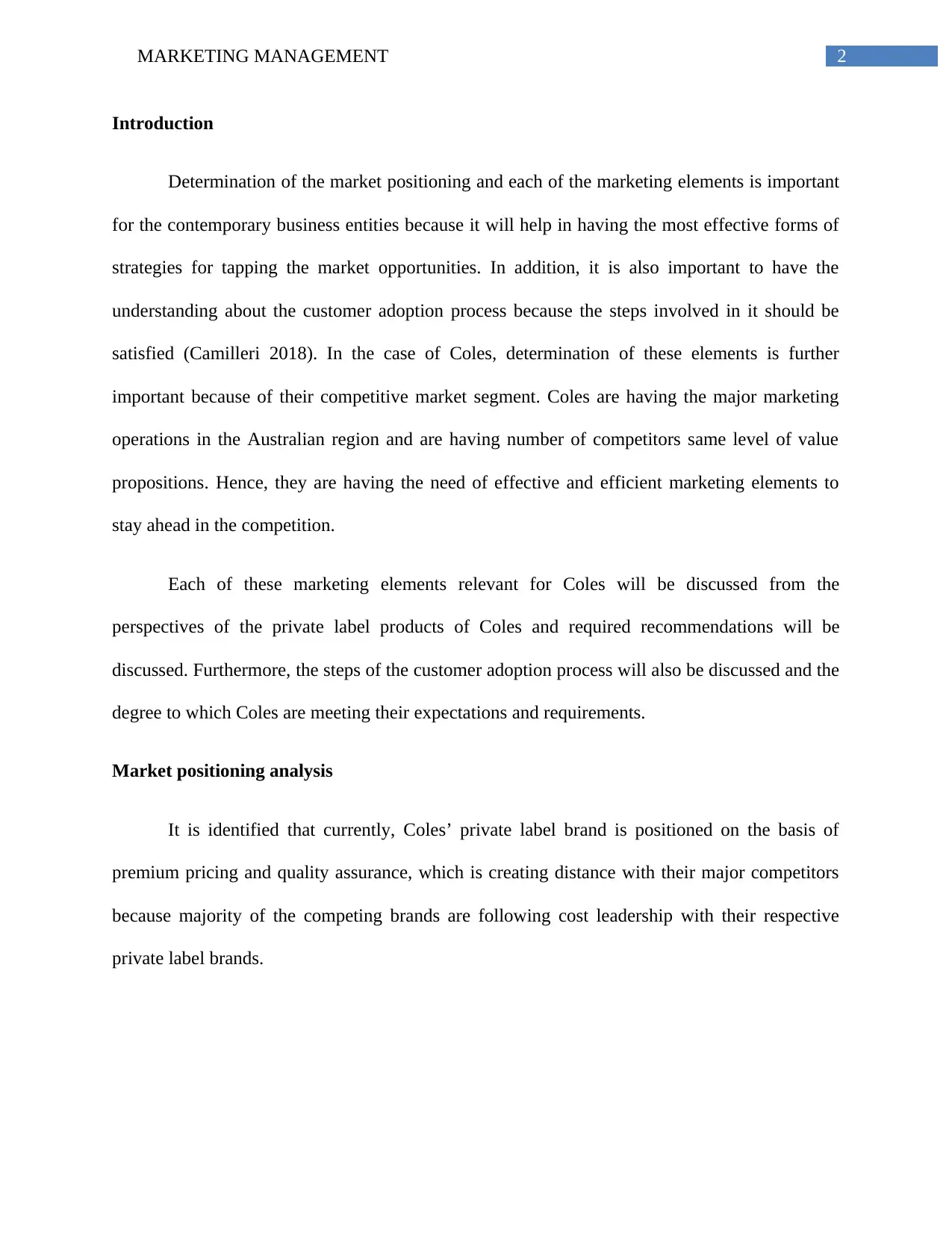
2MARKETING MANAGEMENT
Introduction
Determination of the market positioning and each of the marketing elements is important
for the contemporary business entities because it will help in having the most effective forms of
strategies for tapping the market opportunities. In addition, it is also important to have the
understanding about the customer adoption process because the steps involved in it should be
satisfied (Camilleri 2018). In the case of Coles, determination of these elements is further
important because of their competitive market segment. Coles are having the major marketing
operations in the Australian region and are having number of competitors same level of value
propositions. Hence, they are having the need of effective and efficient marketing elements to
stay ahead in the competition.
Each of these marketing elements relevant for Coles will be discussed from the
perspectives of the private label products of Coles and required recommendations will be
discussed. Furthermore, the steps of the customer adoption process will also be discussed and the
degree to which Coles are meeting their expectations and requirements.
Market positioning analysis
It is identified that currently, Coles’ private label brand is positioned on the basis of
premium pricing and quality assurance, which is creating distance with their major competitors
because majority of the competing brands are following cost leadership with their respective
private label brands.
Introduction
Determination of the market positioning and each of the marketing elements is important
for the contemporary business entities because it will help in having the most effective forms of
strategies for tapping the market opportunities. In addition, it is also important to have the
understanding about the customer adoption process because the steps involved in it should be
satisfied (Camilleri 2018). In the case of Coles, determination of these elements is further
important because of their competitive market segment. Coles are having the major marketing
operations in the Australian region and are having number of competitors same level of value
propositions. Hence, they are having the need of effective and efficient marketing elements to
stay ahead in the competition.
Each of these marketing elements relevant for Coles will be discussed from the
perspectives of the private label products of Coles and required recommendations will be
discussed. Furthermore, the steps of the customer adoption process will also be discussed and the
degree to which Coles are meeting their expectations and requirements.
Market positioning analysis
It is identified that currently, Coles’ private label brand is positioned on the basis of
premium pricing and quality assurance, which is creating distance with their major competitors
because majority of the competing brands are following cost leadership with their respective
private label brands.
⊘ This is a preview!⊘
Do you want full access?
Subscribe today to unlock all pages.

Trusted by 1+ million students worldwide

3MARKETING MANAGEMENT
High price
Low price
Low product quality High product quality
Kmart
ALDI
Coles
Woolworths
The above positioning map is reflecting that close competition for Coles is low as none of
the competing brands are operating in the high price segment other than the exclusive brands. It
is further recommended that Coles can position their private label brand on the basis of
competitors due to the reason if the value propositions of all the competing brands are same, then
the point of difference will get reduced and competitiveness cannot be gained (Asdemir,
Fernando and Tripathy 2013). Hence, based on the competitors, market positioning should be
done to gain the distinctiveness in large scale by Coles.
High price
Low price
Low product quality High product quality
Kmart
ALDI
Coles
Woolworths
The above positioning map is reflecting that close competition for Coles is low as none of
the competing brands are operating in the high price segment other than the exclusive brands. It
is further recommended that Coles can position their private label brand on the basis of
competitors due to the reason if the value propositions of all the competing brands are same, then
the point of difference will get reduced and competitiveness cannot be gained (Asdemir,
Fernando and Tripathy 2013). Hence, based on the competitors, market positioning should be
done to gain the distinctiveness in large scale by Coles.
Paraphrase This Document
Need a fresh take? Get an instant paraphrase of this document with our AI Paraphraser
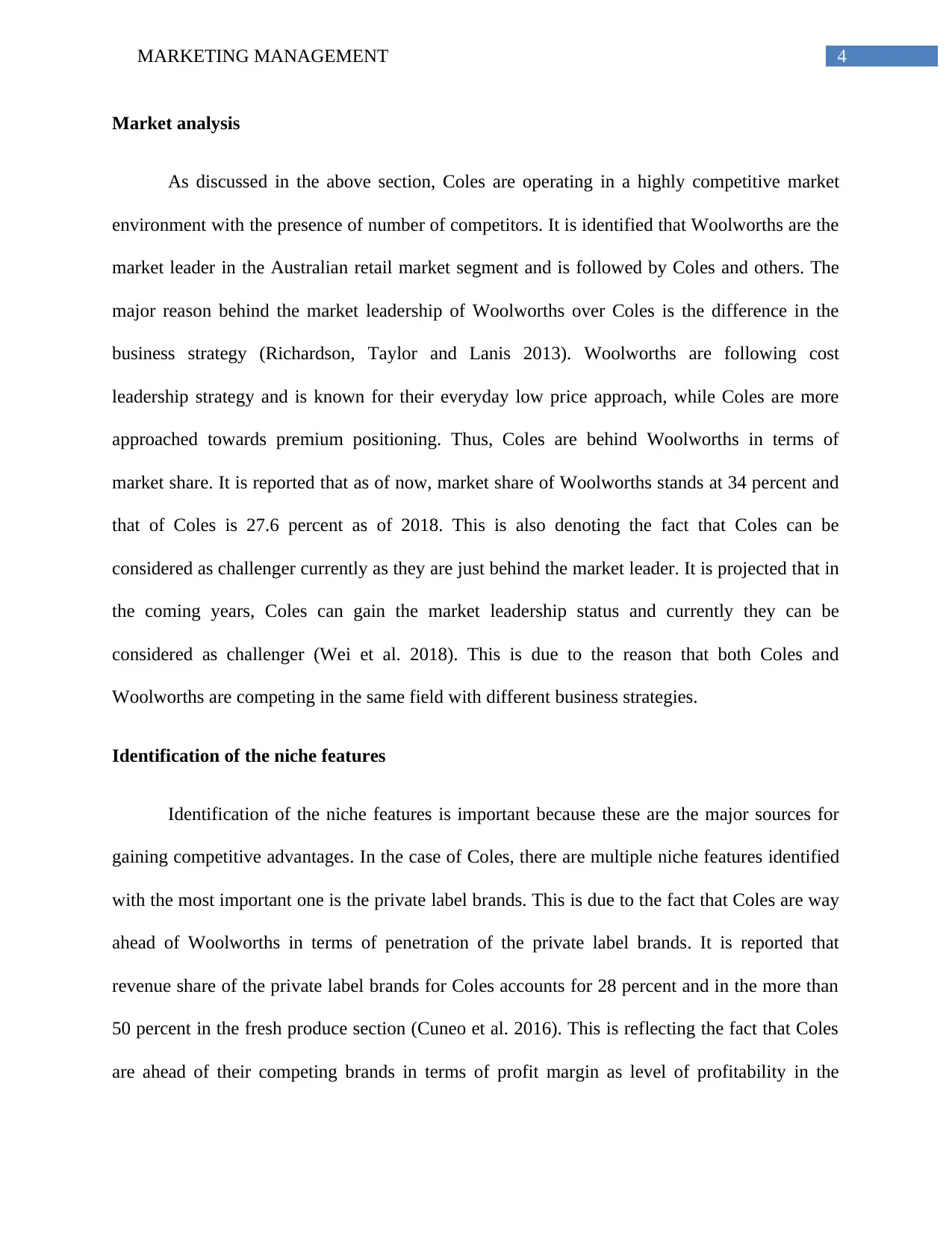
4MARKETING MANAGEMENT
Market analysis
As discussed in the above section, Coles are operating in a highly competitive market
environment with the presence of number of competitors. It is identified that Woolworths are the
market leader in the Australian retail market segment and is followed by Coles and others. The
major reason behind the market leadership of Woolworths over Coles is the difference in the
business strategy (Richardson, Taylor and Lanis 2013). Woolworths are following cost
leadership strategy and is known for their everyday low price approach, while Coles are more
approached towards premium positioning. Thus, Coles are behind Woolworths in terms of
market share. It is reported that as of now, market share of Woolworths stands at 34 percent and
that of Coles is 27.6 percent as of 2018. This is also denoting the fact that Coles can be
considered as challenger currently as they are just behind the market leader. It is projected that in
the coming years, Coles can gain the market leadership status and currently they can be
considered as challenger (Wei et al. 2018). This is due to the reason that both Coles and
Woolworths are competing in the same field with different business strategies.
Identification of the niche features
Identification of the niche features is important because these are the major sources for
gaining competitive advantages. In the case of Coles, there are multiple niche features identified
with the most important one is the private label brands. This is due to the fact that Coles are way
ahead of Woolworths in terms of penetration of the private label brands. It is reported that
revenue share of the private label brands for Coles accounts for 28 percent and in the more than
50 percent in the fresh produce section (Cuneo et al. 2016). This is reflecting the fact that Coles
are ahead of their competing brands in terms of profit margin as level of profitability in the
Market analysis
As discussed in the above section, Coles are operating in a highly competitive market
environment with the presence of number of competitors. It is identified that Woolworths are the
market leader in the Australian retail market segment and is followed by Coles and others. The
major reason behind the market leadership of Woolworths over Coles is the difference in the
business strategy (Richardson, Taylor and Lanis 2013). Woolworths are following cost
leadership strategy and is known for their everyday low price approach, while Coles are more
approached towards premium positioning. Thus, Coles are behind Woolworths in terms of
market share. It is reported that as of now, market share of Woolworths stands at 34 percent and
that of Coles is 27.6 percent as of 2018. This is also denoting the fact that Coles can be
considered as challenger currently as they are just behind the market leader. It is projected that in
the coming years, Coles can gain the market leadership status and currently they can be
considered as challenger (Wei et al. 2018). This is due to the reason that both Coles and
Woolworths are competing in the same field with different business strategies.
Identification of the niche features
Identification of the niche features is important because these are the major sources for
gaining competitive advantages. In the case of Coles, there are multiple niche features identified
with the most important one is the private label brands. This is due to the fact that Coles are way
ahead of Woolworths in terms of penetration of the private label brands. It is reported that
revenue share of the private label brands for Coles accounts for 28 percent and in the more than
50 percent in the fresh produce section (Cuneo et al. 2016). This is reflecting the fact that Coles
are ahead of their competing brands in terms of profit margin as level of profitability in the
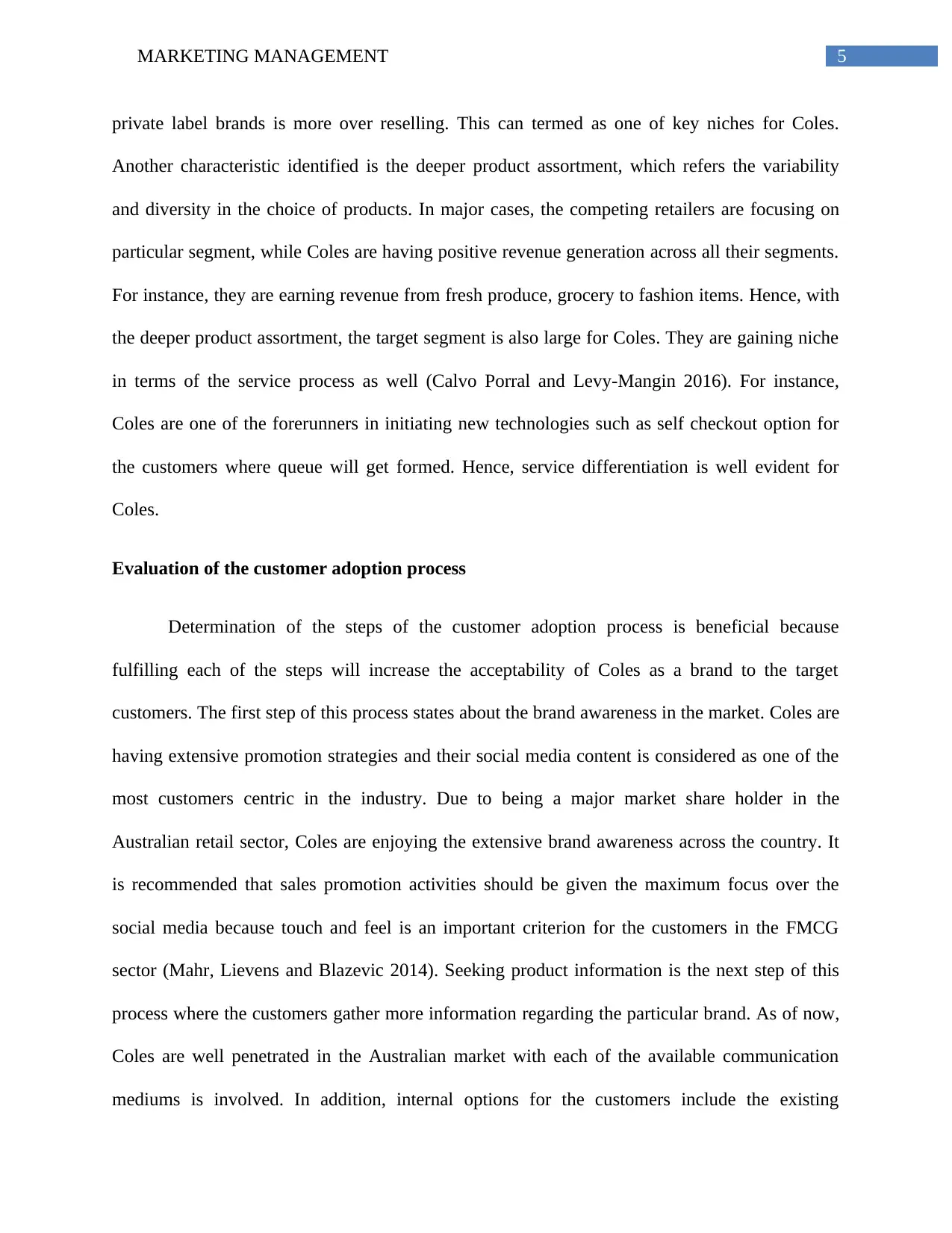
5MARKETING MANAGEMENT
private label brands is more over reselling. This can termed as one of key niches for Coles.
Another characteristic identified is the deeper product assortment, which refers the variability
and diversity in the choice of products. In major cases, the competing retailers are focusing on
particular segment, while Coles are having positive revenue generation across all their segments.
For instance, they are earning revenue from fresh produce, grocery to fashion items. Hence, with
the deeper product assortment, the target segment is also large for Coles. They are gaining niche
in terms of the service process as well (Calvo Porral and Levy-Mangin 2016). For instance,
Coles are one of the forerunners in initiating new technologies such as self checkout option for
the customers where queue will get formed. Hence, service differentiation is well evident for
Coles.
Evaluation of the customer adoption process
Determination of the steps of the customer adoption process is beneficial because
fulfilling each of the steps will increase the acceptability of Coles as a brand to the target
customers. The first step of this process states about the brand awareness in the market. Coles are
having extensive promotion strategies and their social media content is considered as one of the
most customers centric in the industry. Due to being a major market share holder in the
Australian retail sector, Coles are enjoying the extensive brand awareness across the country. It
is recommended that sales promotion activities should be given the maximum focus over the
social media because touch and feel is an important criterion for the customers in the FMCG
sector (Mahr, Lievens and Blazevic 2014). Seeking product information is the next step of this
process where the customers gather more information regarding the particular brand. As of now,
Coles are well penetrated in the Australian market with each of the available communication
mediums is involved. In addition, internal options for the customers include the existing
private label brands is more over reselling. This can termed as one of key niches for Coles.
Another characteristic identified is the deeper product assortment, which refers the variability
and diversity in the choice of products. In major cases, the competing retailers are focusing on
particular segment, while Coles are having positive revenue generation across all their segments.
For instance, they are earning revenue from fresh produce, grocery to fashion items. Hence, with
the deeper product assortment, the target segment is also large for Coles. They are gaining niche
in terms of the service process as well (Calvo Porral and Levy-Mangin 2016). For instance,
Coles are one of the forerunners in initiating new technologies such as self checkout option for
the customers where queue will get formed. Hence, service differentiation is well evident for
Coles.
Evaluation of the customer adoption process
Determination of the steps of the customer adoption process is beneficial because
fulfilling each of the steps will increase the acceptability of Coles as a brand to the target
customers. The first step of this process states about the brand awareness in the market. Coles are
having extensive promotion strategies and their social media content is considered as one of the
most customers centric in the industry. Due to being a major market share holder in the
Australian retail sector, Coles are enjoying the extensive brand awareness across the country. It
is recommended that sales promotion activities should be given the maximum focus over the
social media because touch and feel is an important criterion for the customers in the FMCG
sector (Mahr, Lievens and Blazevic 2014). Seeking product information is the next step of this
process where the customers gather more information regarding the particular brand. As of now,
Coles are well penetrated in the Australian market with each of the available communication
mediums is involved. In addition, internal options for the customers include the existing
⊘ This is a preview!⊘
Do you want full access?
Subscribe today to unlock all pages.

Trusted by 1+ million students worldwide
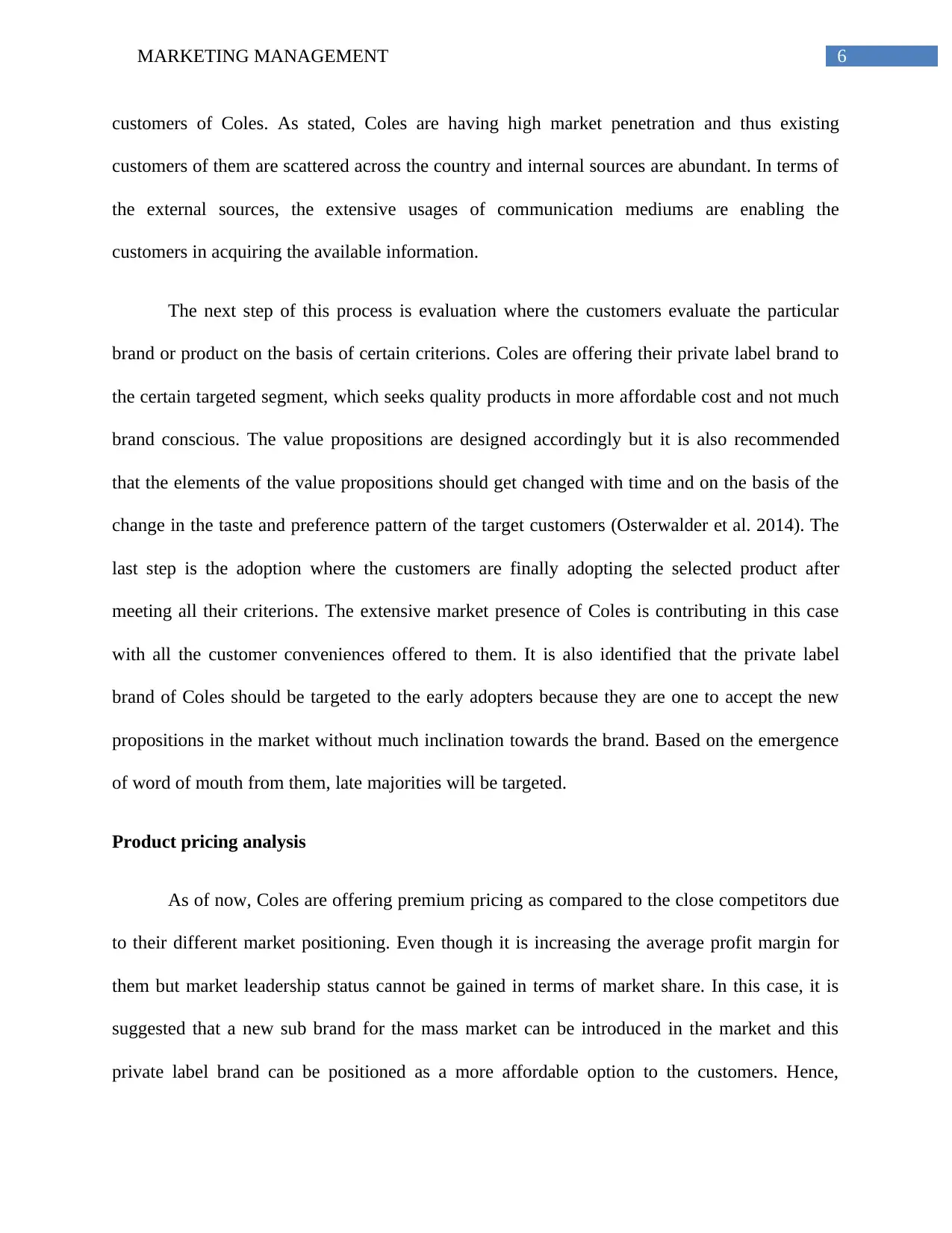
6MARKETING MANAGEMENT
customers of Coles. As stated, Coles are having high market penetration and thus existing
customers of them are scattered across the country and internal sources are abundant. In terms of
the external sources, the extensive usages of communication mediums are enabling the
customers in acquiring the available information.
The next step of this process is evaluation where the customers evaluate the particular
brand or product on the basis of certain criterions. Coles are offering their private label brand to
the certain targeted segment, which seeks quality products in more affordable cost and not much
brand conscious. The value propositions are designed accordingly but it is also recommended
that the elements of the value propositions should get changed with time and on the basis of the
change in the taste and preference pattern of the target customers (Osterwalder et al. 2014). The
last step is the adoption where the customers are finally adopting the selected product after
meeting all their criterions. The extensive market presence of Coles is contributing in this case
with all the customer conveniences offered to them. It is also identified that the private label
brand of Coles should be targeted to the early adopters because they are one to accept the new
propositions in the market without much inclination towards the brand. Based on the emergence
of word of mouth from them, late majorities will be targeted.
Product pricing analysis
As of now, Coles are offering premium pricing as compared to the close competitors due
to their different market positioning. Even though it is increasing the average profit margin for
them but market leadership status cannot be gained in terms of market share. In this case, it is
suggested that a new sub brand for the mass market can be introduced in the market and this
private label brand can be positioned as a more affordable option to the customers. Hence,
customers of Coles. As stated, Coles are having high market penetration and thus existing
customers of them are scattered across the country and internal sources are abundant. In terms of
the external sources, the extensive usages of communication mediums are enabling the
customers in acquiring the available information.
The next step of this process is evaluation where the customers evaluate the particular
brand or product on the basis of certain criterions. Coles are offering their private label brand to
the certain targeted segment, which seeks quality products in more affordable cost and not much
brand conscious. The value propositions are designed accordingly but it is also recommended
that the elements of the value propositions should get changed with time and on the basis of the
change in the taste and preference pattern of the target customers (Osterwalder et al. 2014). The
last step is the adoption where the customers are finally adopting the selected product after
meeting all their criterions. The extensive market presence of Coles is contributing in this case
with all the customer conveniences offered to them. It is also identified that the private label
brand of Coles should be targeted to the early adopters because they are one to accept the new
propositions in the market without much inclination towards the brand. Based on the emergence
of word of mouth from them, late majorities will be targeted.
Product pricing analysis
As of now, Coles are offering premium pricing as compared to the close competitors due
to their different market positioning. Even though it is increasing the average profit margin for
them but market leadership status cannot be gained in terms of market share. In this case, it is
suggested that a new sub brand for the mass market can be introduced in the market and this
private label brand can be positioned as a more affordable option to the customers. Hence,
Paraphrase This Document
Need a fresh take? Get an instant paraphrase of this document with our AI Paraphraser

7MARKETING MANAGEMENT
market penetration pricing should be implemented to gain the higher market share in the long
term (Schmidt, Spann and Zeithammer 2014). This new pricing strategy coupled with the
existing pricing strategy of Coles will ensure their market leadership status.
Product distribution analysis
As of now, Coles are following direct channel because they have established forward
integration process and for the private label brands, external suppliers are leveraged. They are
sourced from the external suppliers and sold directly via the retail stores and online stores of
Coles. On the basis of this, it is further suggested that smaller offline counters or touch points
can be introduced for tier II and III cities where the customers prefer affordable products and
quality assurance (Matsui 2016). This will increase the market penetration and availability of
Coles in their existing market. Hours of operation will be the normal working time schedule and
online services can be availed at any point of time. In terms of service and capacity factors,
Coles should have the integrated logistical support for less time consumption in the process
between supply and demand.
Conclusion
This report concludes that the existing market strategies and activities of Coles are
effective and suitable enough for the long term business viability. However, this will not increase
their market share for which, they have to change their existing approaches. In this report, these
new approaches are recommended and it is expected that effective implementation of these
recommended steps can be beneficial and fruitful for Coles in the long term.
market penetration pricing should be implemented to gain the higher market share in the long
term (Schmidt, Spann and Zeithammer 2014). This new pricing strategy coupled with the
existing pricing strategy of Coles will ensure their market leadership status.
Product distribution analysis
As of now, Coles are following direct channel because they have established forward
integration process and for the private label brands, external suppliers are leveraged. They are
sourced from the external suppliers and sold directly via the retail stores and online stores of
Coles. On the basis of this, it is further suggested that smaller offline counters or touch points
can be introduced for tier II and III cities where the customers prefer affordable products and
quality assurance (Matsui 2016). This will increase the market penetration and availability of
Coles in their existing market. Hours of operation will be the normal working time schedule and
online services can be availed at any point of time. In terms of service and capacity factors,
Coles should have the integrated logistical support for less time consumption in the process
between supply and demand.
Conclusion
This report concludes that the existing market strategies and activities of Coles are
effective and suitable enough for the long term business viability. However, this will not increase
their market share for which, they have to change their existing approaches. In this report, these
new approaches are recommended and it is expected that effective implementation of these
recommended steps can be beneficial and fruitful for Coles in the long term.
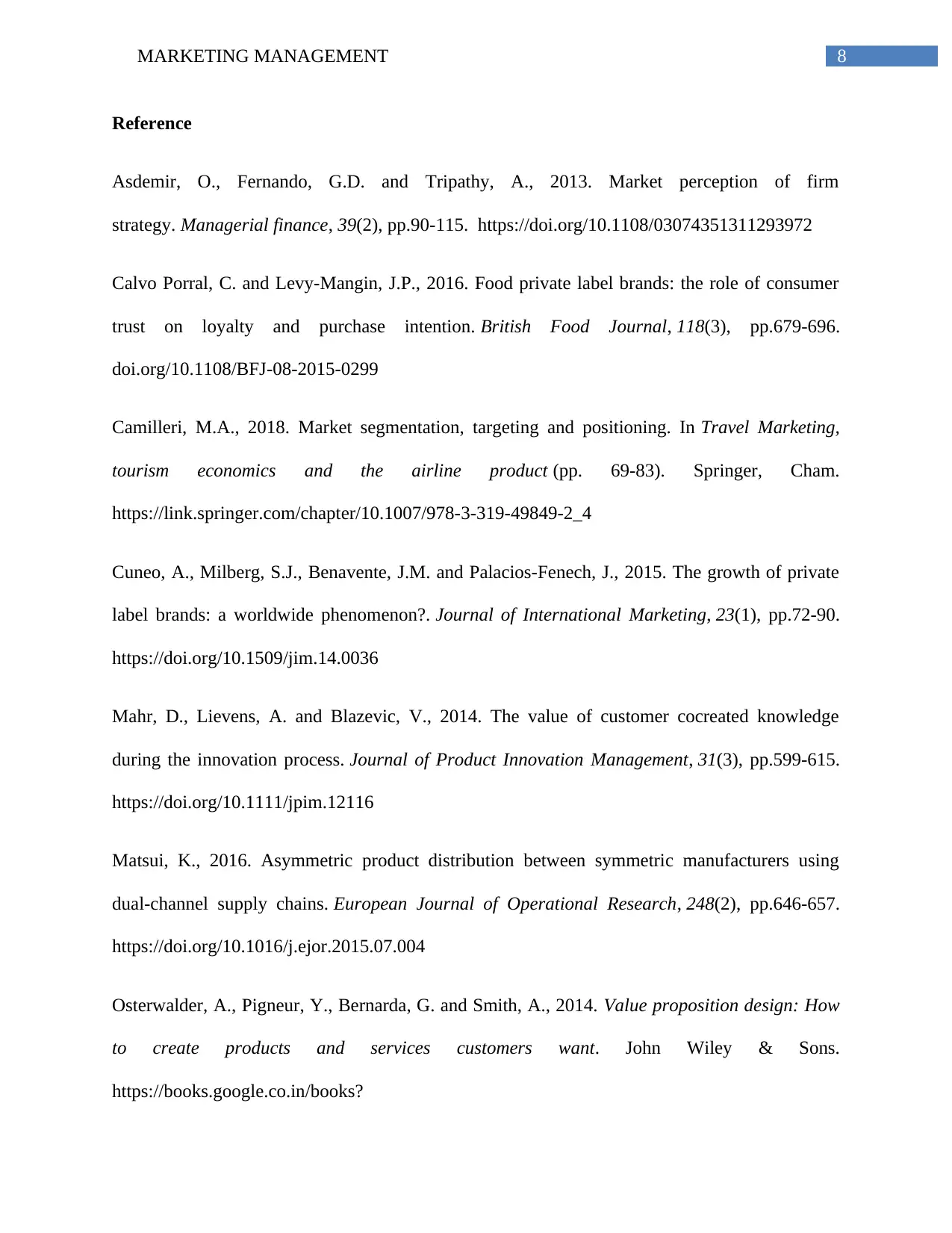
8MARKETING MANAGEMENT
Reference
Asdemir, O., Fernando, G.D. and Tripathy, A., 2013. Market perception of firm
strategy. Managerial finance, 39(2), pp.90-115. https://doi.org/10.1108/03074351311293972
Calvo Porral, C. and Levy-Mangin, J.P., 2016. Food private label brands: the role of consumer
trust on loyalty and purchase intention. British Food Journal, 118(3), pp.679-696.
doi.org/10.1108/BFJ-08-2015-0299
Camilleri, M.A., 2018. Market segmentation, targeting and positioning. In Travel Marketing,
tourism economics and the airline product (pp. 69-83). Springer, Cham.
https://link.springer.com/chapter/10.1007/978-3-319-49849-2_4
Cuneo, A., Milberg, S.J., Benavente, J.M. and Palacios-Fenech, J., 2015. The growth of private
label brands: a worldwide phenomenon?. Journal of International Marketing, 23(1), pp.72-90.
https://doi.org/10.1509/jim.14.0036
Mahr, D., Lievens, A. and Blazevic, V., 2014. The value of customer cocreated knowledge
during the innovation process. Journal of Product Innovation Management, 31(3), pp.599-615.
https://doi.org/10.1111/jpim.12116
Matsui, K., 2016. Asymmetric product distribution between symmetric manufacturers using
dual-channel supply chains. European Journal of Operational Research, 248(2), pp.646-657.
https://doi.org/10.1016/j.ejor.2015.07.004
Osterwalder, A., Pigneur, Y., Bernarda, G. and Smith, A., 2014. Value proposition design: How
to create products and services customers want. John Wiley & Sons.
https://books.google.co.in/books?
Reference
Asdemir, O., Fernando, G.D. and Tripathy, A., 2013. Market perception of firm
strategy. Managerial finance, 39(2), pp.90-115. https://doi.org/10.1108/03074351311293972
Calvo Porral, C. and Levy-Mangin, J.P., 2016. Food private label brands: the role of consumer
trust on loyalty and purchase intention. British Food Journal, 118(3), pp.679-696.
doi.org/10.1108/BFJ-08-2015-0299
Camilleri, M.A., 2018. Market segmentation, targeting and positioning. In Travel Marketing,
tourism economics and the airline product (pp. 69-83). Springer, Cham.
https://link.springer.com/chapter/10.1007/978-3-319-49849-2_4
Cuneo, A., Milberg, S.J., Benavente, J.M. and Palacios-Fenech, J., 2015. The growth of private
label brands: a worldwide phenomenon?. Journal of International Marketing, 23(1), pp.72-90.
https://doi.org/10.1509/jim.14.0036
Mahr, D., Lievens, A. and Blazevic, V., 2014. The value of customer cocreated knowledge
during the innovation process. Journal of Product Innovation Management, 31(3), pp.599-615.
https://doi.org/10.1111/jpim.12116
Matsui, K., 2016. Asymmetric product distribution between symmetric manufacturers using
dual-channel supply chains. European Journal of Operational Research, 248(2), pp.646-657.
https://doi.org/10.1016/j.ejor.2015.07.004
Osterwalder, A., Pigneur, Y., Bernarda, G. and Smith, A., 2014. Value proposition design: How
to create products and services customers want. John Wiley & Sons.
https://books.google.co.in/books?
⊘ This is a preview!⊘
Do you want full access?
Subscribe today to unlock all pages.

Trusted by 1+ million students worldwide
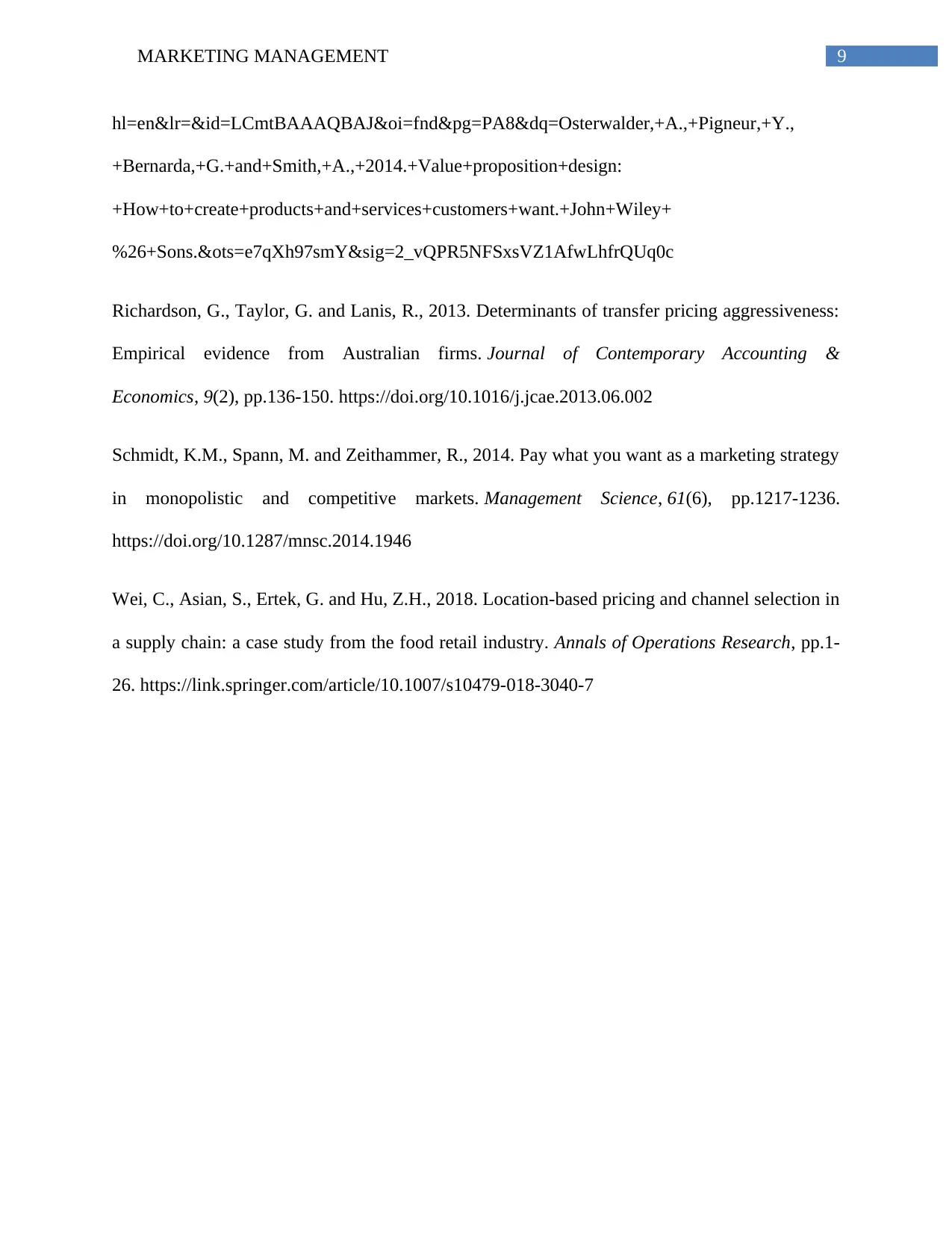
9MARKETING MANAGEMENT
hl=en&lr=&id=LCmtBAAAQBAJ&oi=fnd&pg=PA8&dq=Osterwalder,+A.,+Pigneur,+Y.,
+Bernarda,+G.+and+Smith,+A.,+2014.+Value+proposition+design:
+How+to+create+products+and+services+customers+want.+John+Wiley+
%26+Sons.&ots=e7qXh97smY&sig=2_vQPR5NFSxsVZ1AfwLhfrQUq0c
Richardson, G., Taylor, G. and Lanis, R., 2013. Determinants of transfer pricing aggressiveness:
Empirical evidence from Australian firms. Journal of Contemporary Accounting &
Economics, 9(2), pp.136-150. https://doi.org/10.1016/j.jcae.2013.06.002
Schmidt, K.M., Spann, M. and Zeithammer, R., 2014. Pay what you want as a marketing strategy
in monopolistic and competitive markets. Management Science, 61(6), pp.1217-1236.
https://doi.org/10.1287/mnsc.2014.1946
Wei, C., Asian, S., Ertek, G. and Hu, Z.H., 2018. Location-based pricing and channel selection in
a supply chain: a case study from the food retail industry. Annals of Operations Research, pp.1-
26. https://link.springer.com/article/10.1007/s10479-018-3040-7
hl=en&lr=&id=LCmtBAAAQBAJ&oi=fnd&pg=PA8&dq=Osterwalder,+A.,+Pigneur,+Y.,
+Bernarda,+G.+and+Smith,+A.,+2014.+Value+proposition+design:
+How+to+create+products+and+services+customers+want.+John+Wiley+
%26+Sons.&ots=e7qXh97smY&sig=2_vQPR5NFSxsVZ1AfwLhfrQUq0c
Richardson, G., Taylor, G. and Lanis, R., 2013. Determinants of transfer pricing aggressiveness:
Empirical evidence from Australian firms. Journal of Contemporary Accounting &
Economics, 9(2), pp.136-150. https://doi.org/10.1016/j.jcae.2013.06.002
Schmidt, K.M., Spann, M. and Zeithammer, R., 2014. Pay what you want as a marketing strategy
in monopolistic and competitive markets. Management Science, 61(6), pp.1217-1236.
https://doi.org/10.1287/mnsc.2014.1946
Wei, C., Asian, S., Ertek, G. and Hu, Z.H., 2018. Location-based pricing and channel selection in
a supply chain: a case study from the food retail industry. Annals of Operations Research, pp.1-
26. https://link.springer.com/article/10.1007/s10479-018-3040-7
1 out of 10
Related Documents
Your All-in-One AI-Powered Toolkit for Academic Success.
+13062052269
info@desklib.com
Available 24*7 on WhatsApp / Email
![[object Object]](/_next/static/media/star-bottom.7253800d.svg)
Unlock your academic potential
Copyright © 2020–2025 A2Z Services. All Rights Reserved. Developed and managed by ZUCOL.




